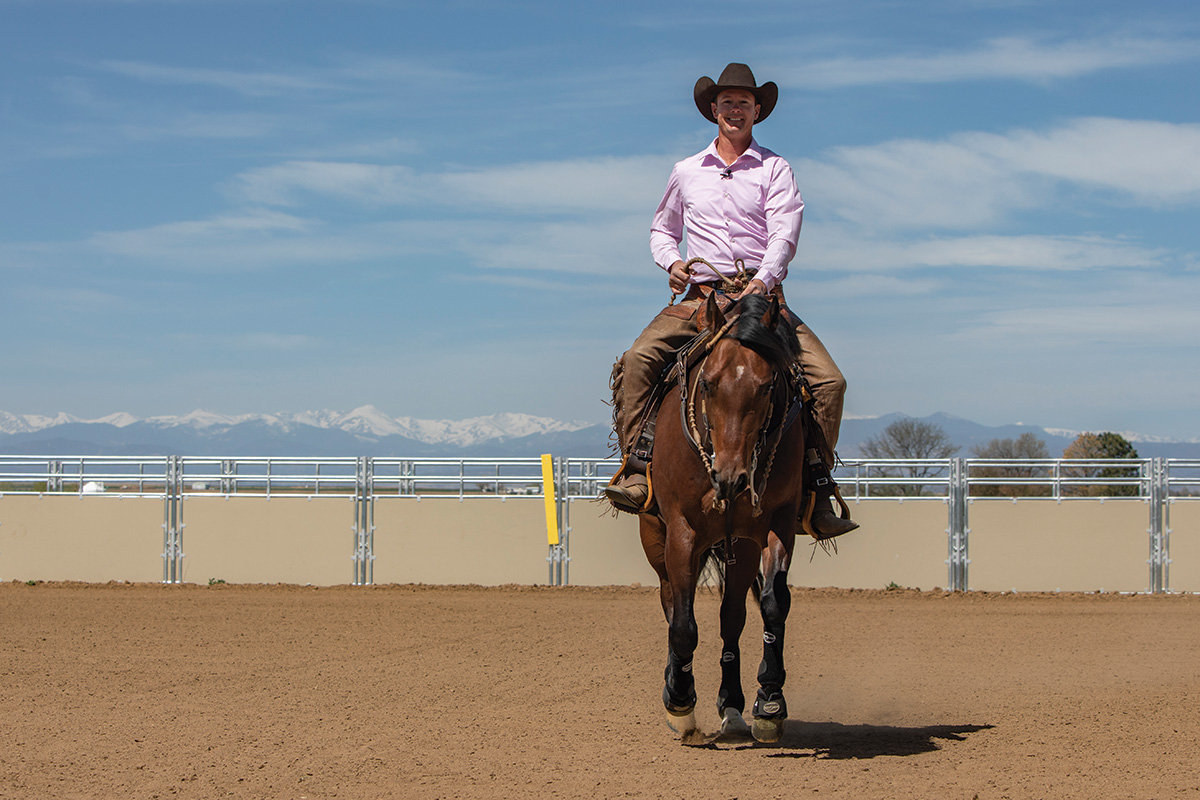It’s no fun to ride a horse that needs to be pushed constantly to stay in a lope. It feels like pedaling a bicycle when you must use your legs in rhythmic cues knowing the horse will break gait if you don’t keep it up. It’s time to start training your horse to keep loping until he’s asked to do something different.

No Nagging
“If you constantly nag a child about cleaning their room but there’s no follow-through or consequence, they’ll soon learn they don’t have to clean their room,” says Crow. “It’s the same way for the horse. If you kiss to the horse and he doesn’t step into and stay in the lope, there must be a follow-through. If there isn’t a follow-through, you’re effectively training your horse to ignore you. He’ll take you up on the chance to ignore you if allowed. The horse may break down into the trot or just get hollow. Most horses will only work as hard as you ask them to. Make sure you’re following up.”
In the show pen, the judge wants to see a horse that is willingly guided. The horse should step into a transition with fluidity and a willing demeanor. Crow says that your horse’s willingness to lope freely will affect your performance scores for several transitions and maneuvers.

“If you see a rider who’s having to beg the horse to go forward, it’s not a very pretty picture,” Crow says. “Maybe a judge won’t minus all of the maneuvers, but he certainly isn’t going to plus the maneuvers. If a rider is having a discussion with the horse about just staying in the lope, there’s no chance she could have shown an extended lope. Then she won’t be able to show a transition to a collected lope. Also, if you’re begging your horse to stay in the lope, he can’t have the balance to show a good transition from the lope to the trot.”
Making the Change
“Horses that need to be pedaled all the time may never have been taught to move forward freely,” says Crow. “Horses can get dull and lazy when the rider allows that behavior. If a rider is timid or isn’t clear with the horse, it’s easy for him to just stop.”
Crow says he helps horses break the pedaling cycle by showing them that they can move out freely. He’ll ask the horse to lope and boost the speed to show the horse he can move out and will be expected to move at the speed requested.
First, Crow teaches the horse that there will be an audible cue before any follow through or consequence. He makes a kissing sound to ask for the lope, then uses his leg pressure to reinforce the sound. Once he’s loping, he kisses again to ask for more speed.
“The sound will be followed by my leg cues—with a little more outside leg cue to keep the horse moving forward,” he says. “When the horse learns a verbal cue before the leg cue, he learns that he needs to move on. The verbal cue was the ask, and the leg cue was the tell. If the horse still doesn’t respond, I’ll bump with my leg, but I won’t continue to bump. If I were to constantly bump, I’d desensitize the horse to my leg.”
If a horse has been ridden with constant leg cues, Crow suggests the rider carry a short crop.
“I teach riders to use a verbal cue first, then their legs, then a tap on the hindquarters (at the hip) will be a new cue that the horse isn’t desensitized to,” says Crow. “We aren’t talking about hitting the horse hard at all, just providing a new feeling and something the horse isn’t desensitized to. Usually it only takes one or two taps for the horse to understand that he should move off of the kiss sound and not wait for other aids.”
Loping Position
If you have to canter, push, canter, push on a horse to prevent him from breaking gait, you may have developed a habit you’ll need to break.
Crow says to make sure you’re sitting on your hips and using your legs. If you’ve become accustomed to begging the horse to go, you may have learned to lean forward to encourage him. This position actually moves your legs away from the horse. You don’t have the ability to use your leg aids as well as if you can sit back, drive and push the horse forward from your seat. Think of driving instead of leaning forward and taking the horse with you.

Riding a different horse can help you feel what you were doing and allow you to sit up and change your posture.
“Sometimes it’s helpful to get on a horse that will keep the lope so you can feel what it’s like to just ride,” advises Crow. “Many times, riders who have learned to bump every stride will lean forward so their legs aren’t in the place to drive. It’s important to learn to sit back and allow your legs to open and drive the horse with a long, relaxed leg.”

Meet the TrainerCody Crow owns and operates No Where but Up Performance Horses with his team of trainers in Johnstown, Colo. He trains horses and riders to compete in versatility ranch horse, ranch riding, ranch trail, and reined cow horse competitions. He has earned world and reserve world championships and helped his horses earn titles in American Quarter Horse Association, American Paint Horse Association, Appaloosa Horse Club, National Reined Cow Horse Association, and National Snaffle Bit Association events. |
This article about breaking gait at the lope appeared in the March 2023 issue of Horse Illustrated magazine. Click here to subscribe!





